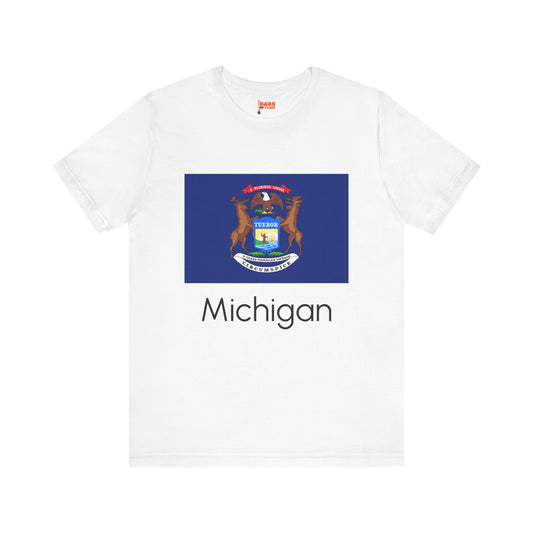-
Michigan Sweatshirt
Regular price $34.15 USDRegular priceUnit price / per -
Michigan Backpack
Regular price $59.79 USDRegular priceUnit price / per -
Michigan Pillow
Regular price $22.65 USDRegular priceUnit price / per -
Michigan Mug
Regular price $11.65 USDRegular priceUnit price / per -
Michigan Trucker Cap
Regular price $14.90 USDRegular priceUnit price / per -
Michigan Leather Patch Hat
Regular price $18.85 USDRegular priceUnit price / per -
Michigan Flag Sweatshirt
Regular price $34.15 USDRegular priceUnit price / per -
Michigan Inspired Sweatshirt
Regular price $34.15 USDRegular priceUnit price / per -
Michigan Hoodies
Regular price $34.40 USDRegular priceUnit price / per -
Michigan T-shirts
Regular price $22.79 USDRegular priceUnit price / per -
Michigan Flag Hoodies
Regular price $34.40 USDRegular priceUnit price / per -
Michigan Inspired Hoodie
Regular price $34.40 USDRegular priceUnit price / per -
Michigan Inspired T-shirt
Regular price $22.79 USDRegular priceUnit price / per -
Michigan Flag T-shirts
Regular price $22.79 USDRegular priceUnit price / per
Collection: US State: Michigan MI flag
The Michigan flag, also known as the flag of Michigan, is a symbol of pride and identity for the residents of the Great Lakes State. With a unique design and colors, this flag holds historical significance and deep symbolism. We will delve into the details of the Michigan flag, exploring its design, historical context, symbolism, current relevance, and additional facts.
Overview of the Michigan Flag

At the heart of the Michigan flag's design is a rich, dark blue field that serves as the backdrop for the state's coat of arms. This emblem features a majestic eagle, wings unfurled, clutching an olive branch and arrows, signifying a balance between peace and readiness for defense. Encircling this eagle are the Latin phrases "E Pluribus Unum" and "Tuebor," translating to "Out of Many, One" and "I Will Defend," respectively, which emphasize unity and protection.
Above the eagle, a shield showcases a man standing on a peninsula, a direct nod to Michigan's distinctive geography, flanked by the Great Lakes. This composition is not just an artistic choice but a deliberate representation of the state's ideals, heritage, and its inseparable connection to the natural beauty that defines it. Through these elements, the Michigan flag encapsulates the state's spirit and physical essence, symbolizing loyalty, integrity, and the enduring bond between its people and the land.
Historical Context of the Michigan Flag
The journey to the current Michigan flag began long before its official adoption in 1911. Michigan's flag history is marked by a series of iterations, with the first state flag being introduced in 1865. This initial version was quite different from what we see today, showcasing Michigan's early attempts at encapsulating its values and identity through symbols and colors. The transition to the 1911 design was fueled by a desire to accurately represent the state's ideals and geographical uniqueness.
The adoption process was influenced by various historical events, including Michigan's rapid growth and its evolving role within the United States. The flag, as we know it today, has remained unchanged for over a century, serving as a constant emblem of Michigan's enduring spirit. Its longevity speaks to the strength of the symbols that represent the state. Each was carefully selected to convey aspects of Michigan's identity that were deemed timeless. This rich history adds a layer of depth to the flag, making it not just a symbol of the state as it is today but a reflection of its journey and evolution over time.
Symbolism Embedded in the Flag
The vibrant dark blue field of the Michigan flag not only signifies loyalty and integrity but also mirrors the state’s vast waterways and skies, reflecting its deep connection with the Great Lakes and the natural world. Central to the flag's design, the eagle embodies the United States, reflecting Michigan's integral role in the nation while highlighting the state's strength and courage. This eagle holds an olive branch and arrows, a classic symbol balancing the desire for peace with the readiness for defense, encapsulating Michigan's values of harmony and resilience.
The shield, prominently featuring a man standing on a peninsula, directly alludes to Michigan’s geographic distinctiveness, surrounded by the Great Lakes. This figure stands confidently, symbolizing the people of Michigan’s independence and steadfast connection to the land and its resources. Above this, the mottos “E Pluribus Unum” and “Tuebor” weave a narrative of unity and defense, proclaiming a commitment to collective identity and protecting the state's values and freedoms. Together, these elements craft a narrative of a state deeply intertwined with its natural environment and its place within the broader American tapestry, celebrating Michigan’s unique identity, heritage, and the enduring spirit of its people.
Current Relevance of the Michigan Flag
Today, the Michigan flag plays a significant role in public life across the state. It can be seen flying high at state buildings and educational institutions and is a central feature in military honors, embodying the pride and heritage of Michigan. The flag is a ceremonial emblem and a vital part of state identity. It actively participates in national and local celebrations, such as Independence Day parades and state fairs, symbolizing unity and collective pride. Despite its storied history and the affection many hold for it, the flag has sparked debates over its design's modern relevance.
Discussions have emerged about whether the flag, with its complex symbols and historical references, fully represents the state's current diversity and progressive values. These conversations highlight the dynamic relationship between the flag and Michigan's evolving identity, reflecting a broader national trend of reevaluating historical symbols to ensure they align with contemporary values. While no changes have been made, these discussions underscore the flag's ongoing importance in Michigan's cultural and political landscape, indicating that it remains a living symbol with the potential to adapt and resonate with future generations.
Additional Facts and Protocols Surrounding the Michigan Flag
In the realm of etiquette surrounding the Michigan flag, certain rules are in place to ensure its honorable display. When positioned alongside the flag of the United States, it is proper for the Michigan flag to be placed on the observer's left, as the US flag takes precedence and should be to the flag's right. Care is also mandated in its handling; the flag must be prevented from making contact with the ground, symbolizing respect and reverence for what it represents. An interesting note is the presence of a human figure on the Michigan flag, a rarity among state flags, which underscores the state's distinctive character and heritage.
This depiction is a potent reminder of the people's enduring connection to Michigan's landscape and history. Additionally, the Michigan flag is honored in various contexts, including official state ceremonies and public displays, where it is flown with dignity. These protocols and practices underscore the importance of the flag as a symbol of state pride and the collective values of its inhabitants, echoing the reverence with which it is regarded by Michiganders and beyond.




























